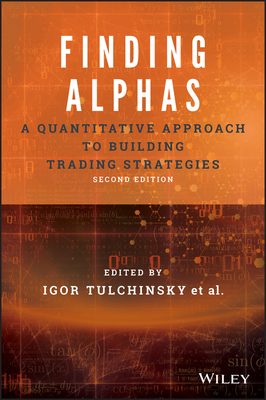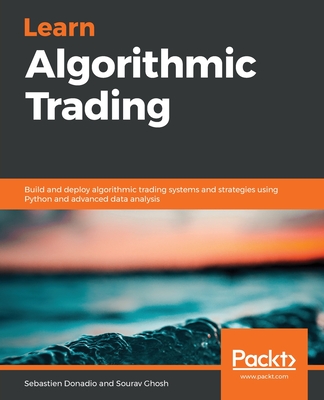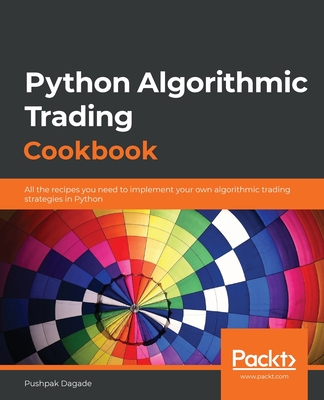Learn Algorithmic Trading
Build and deploy algorithmic trading systems and strategies using Python and advanced data analysis
暫譯: 學習演算法交易
Ghosh, Sourav, Donadio, Sebastien
- 出版商: Packt Publishing
- 出版日期: 2019-11-08
- 定價: $1,900
- 售價: 9.0 折 $1,710
- 語言: 英文
- 頁數: 394
- 裝訂: Paperback
- ISBN: 178934834X
- ISBN-13: 9781789348347
-
相關分類:
Algorithms-data-structures
-
相關翻譯:
Python 算法交易實戰 (簡中版)
立即出貨 (庫存=1)
買這商品的人也買了...
-
 線性代數 ─ 基礎與應用
線性代數 ─ 基礎與應用$450$405 -
 Graph Mining: Laws, Tools, and Case Studies (Paperback)
Graph Mining: Laws, Tools, and Case Studies (Paperback)$1,780$1,691 -
.jpg) 走進我的交易室:股市贏家交易全攻略練習本 (Study Guide for Come Into My Trading Room:A Complete Guide to Trading)
走進我的交易室:股市贏家交易全攻略練習本 (Study Guide for Come Into My Trading Room:A Complete Guide to Trading)$280$238 -
 Algorithmic and High-Frequency Trading
Algorithmic and High-Frequency Trading$3,150$2,993 -
 $1,617Deep Learning (Hardcover)
$1,617Deep Learning (Hardcover) -
 Probability and Computing: Randomization and Probabilistic Techniques in Algorithms and Data Analysis, 2/e (Hardcover)
Probability and Computing: Randomization and Probabilistic Techniques in Algorithms and Data Analysis, 2/e (Hardcover)$1,680$1,646 -
 金融科技實戰:Python 與量化投資
金融科技實戰:Python 與量化投資$650$507 -
 給工程師的第一本理財書:程式金融交易的 118個入門關鍵技巧
給工程師的第一本理財書:程式金融交易的 118個入門關鍵技巧$500$390 -
 Mathematical Statistics and Data Analysis, 3/e (IE-Paperback)(with CD Data Sets)
Mathematical Statistics and Data Analysis, 3/e (IE-Paperback)(with CD Data Sets)$1,360$1,333 -
 Trading Evolved: Anyone can Build Killer Trading Strategies in Python
Trading Evolved: Anyone can Build Killer Trading Strategies in Python$2,050$1,948 -
 NumPy 高速運算徹底解說 - 六行寫一隻程式?你真懂深度學習?手工算給你看!
NumPy 高速運算徹底解說 - 六行寫一隻程式?你真懂深度學習?手工算給你看!$750$638 -
 圖解 Fintech 的知識與技術
圖解 Fintech 的知識與技術$480$379 -
 $1,788Deep Reinforcement Learning Hands-On, 2/e (Paperback)
$1,788Deep Reinforcement Learning Hands-On, 2/e (Paperback) -
 Machine Learning for Algorithmic Trading, 2/e (Paperback)
Machine Learning for Algorithmic Trading, 2/e (Paperback)$2,300$2,185 -
 $2,119Reinforcement Learning: Industrial Applications of Intelligent Agents
$2,119Reinforcement Learning: Industrial Applications of Intelligent Agents -
 MongoDB 技術手冊, 3/e (MongoDB: The Definitive Guide: Powerful and Scalable Data Storage, 3/e)
MongoDB 技術手冊, 3/e (MongoDB: The Definitive Guide: Powerful and Scalable Data Storage, 3/e)$780$616 -
 Finding Alphas: A Quantitative Approach to Building Trading Strategies
Finding Alphas: A Quantitative Approach to Building Trading Strategies$1,840$1,748 -
 金融怪傑.達文熙教你用 100張圖學會箱子戰法:傳承60年經典理論,融合台股贏家思維,散戶一學就會的交易 SOP大公開
金融怪傑.達文熙教你用 100張圖學會箱子戰法:傳承60年經典理論,融合台股贏家思維,散戶一學就會的交易 SOP大公開$350$298 -
 資料科學的建模基礎 : 別急著 coding!你知道模型的陷阱嗎?
資料科學的建模基礎 : 別急著 coding!你知道模型的陷阱嗎?$599$473 -
 Stocks and Forex Trading: How to Win
Stocks and Forex Trading: How to Win$1,400$1,330 -
 Algorithmic Short Selling with Python: Refine your algorithmic trading edge, consistently generate investment ideas, and build a robust long/short pro (Paperback)
Algorithmic Short Selling with Python: Refine your algorithmic trading edge, consistently generate investment ideas, and build a robust long/short pro (Paperback)$2,200$2,090 -
 $1,418Object-Oriented Python: Master Oop by Building Games and GUIs (Paperback)
$1,418Object-Oriented Python: Master Oop by Building Games and GUIs (Paperback) -
 Keras 大神歸位:深度學習全面進化!用 Python 實作 CNN、RNN、GRU、LSTM、GAN、VAE、Transformer
Keras 大神歸位:深度學習全面進化!用 Python 實作 CNN、RNN、GRU、LSTM、GAN、VAE、Transformer$1,200$948 -
 擴散模型從原理到實戰
擴散模型從原理到實戰$479$455 -
 LangChain 開發手冊 -- OpenAI × LCEL 表達式 × Agent 自動化流程 × RAG 擴展模型知識 × 圖形資料庫 × LangSmith 除錯工具
LangChain 開發手冊 -- OpenAI × LCEL 表達式 × Agent 自動化流程 × RAG 擴展模型知識 × 圖形資料庫 × LangSmith 除錯工具$680$537
商品描述
Key Features
- Understand the power of algorithmic trading in financial markets with real-world examples
- Get up and running with the algorithms used to carry out algorithmic trading
- Learn to build your own algorithmic trading robots which require no human intervention
Book Description
It's now harder than ever to get a significant edge over competitors in terms of speed and efficiency when it comes to algorithmic trading. Relying on sophisticated trading signals, predictive models and strategies can make all the difference. This book will guide you through these aspects, giving you insights into how modern electronic trading markets and participants operate.
You'll start with an introduction to algorithmic trading, along with setting up the environment required to perform the tasks in the book. You'll explore the key components of an algorithmic trading business and aspects you'll need to take into account before starting an automated trading project. Next, you'll focus on designing, building and operating the components required for developing a practical and profitable algorithmic trading business. Later, you'll learn how quantitative trading signals and strategies are developed, and also implement and analyze sophisticated trading strategies such as volatility strategies, economic release strategies, and statistical arbitrage. Finally, you'll create a trading bot from scratch using the algorithms built in the previous sections.
By the end of this book, you'll be well-versed with electronic trading markets and have learned to implement, evaluate and safely operate algorithmic trading strategies in live markets.
What you will learn
- Understand the components of modern algorithmic trading systems and strategies
- Apply machine learning in algorithmic trading signals and strategies using Python
- Build, visualize and analyze trading strategies based on mean reversion, trend, economic releases and more
- Quantify and build a risk management system for Python trading strategies
- Build a backtester to run simulated trading strategies for improving the performance of your trading bot
- Deploy and incorporate trading strategies in the live market to maintain and improve profitability
Who this book is for
This book is for software engineers, financial traders, data analysts, and entrepreneurs. Anyone who wants to get started with algorithmic trading and understand how it works; and learn the components of a trading system, protocols and algorithms required for black box and gray box trading, and techniques for building a completely automated and profitable trading business will also find this book useful.
商品描述(中文翻譯)
**主要特點**
- 透過實際案例了解算法交易在金融市場中的威力
- 快速上手執行算法交易所需的算法
- 學習建立不需要人類干預的算法交易機器人
**書籍描述**
在算法交易方面,獲得顯著的速度和效率優勢比以往任何時候都更難。依賴複雜的交易信號、預測模型和策略可以帶來巨大的差異。本書將引導您了解這些方面,讓您深入了解現代電子交易市場及其參與者的運作方式。
您將從算法交易的介紹開始,並設置執行本書任務所需的環境。您將探索算法交易業務的關鍵組成部分,以及在開始自動化交易項目之前需要考慮的各個方面。接下來,您將專注於設計、構建和運營開發實用且有利可圖的算法交易業務所需的組件。之後,您將學習如何開發量化交易信號和策略,並實施和分析複雜的交易策略,例如波動性策略、經濟發布策略和統計套利。最後,您將從頭開始創建一個交易機器人,使用前面部分構建的算法。
到本書結束時,您將熟悉電子交易市場,並學會在實時市場中實施、評估和安全運行算法交易策略。
**您將學到的內容**
- 了解現代算法交易系統和策略的組成部分
- 使用 Python 在算法交易信號和策略中應用機器學習
- 基於均值回歸、趨勢、經濟發布等構建、可視化和分析交易策略
- 量化並為 Python 交易策略建立風險管理系統
- 建立回測器以運行模擬交易策略,改善您的交易機器人的表現
- 在實時市場中部署和整合交易策略,以維持和提高盈利能力
**本書適合誰**
本書適合軟體工程師、金融交易員、數據分析師和企業家。任何想要開始算法交易並了解其運作方式的人;以及學習交易系統的組成部分、黑箱和灰箱交易所需的協議和算法,以及建立完全自動化和有利可圖的交易業務的技術的人,都會發現本書非常有用。
作者簡介
Sebastien Donadio is the Chief Technology Officer at Tradair, responsible for leading the technology. He has a wide variety of professional experience, including being head of software engineering at HC Technologies, partner and technical director of a high-frequency FX firm, a quantitative trading strategy software developer at Sun Trading, working as project lead for the Department of Defense. He also has research experience with Bull SAS, and an IT Credit Risk Manager with Société Générale while in France. He has taught various computer science courses for the past ten years in the University of Chicago, NYU and Columbia University. His main passion is technology but he is also a scuba diving instructor and an experienced rock-climber.
Sourav Ghosh has worked in several proprietary high-frequency algorithmic trading firms over the last decade. He has built and deployed extremely low latency, high throughput automated trading systems for trading exchanges around the world, across multiple asset classes. He specializes in statistical arbitrage market-making, and pairs trading strategies for the most liquid global futures contracts. He works as a Senior Quantitative Developer at a trading firm in Chicago. He holds a Masters in Computer Science from the University of Southern California. His areas of interest include Computer Architecture, FinTech, Probability Theory and Stochastic Processes, Statistical Learning and Inference Methods, and Natural Language Processing.
作者簡介(中文翻譯)
塞巴斯蒂安·多納迪奧是Tradair的首席技術官,負責領導技術團隊。他擁有多樣的專業經驗,包括擔任HC Technologies的軟體工程主管、高頻外匯公司的合夥人及技術總監、Sun Trading的量化交易策略軟體開發者,以及擔任國防部的專案負責人。他還曾在Bull SAS進行研究,並在法國的法國興業銀行擔任IT信用風險經理。在過去十年中,他在芝加哥大學、紐約大學和哥倫比亞大學教授各種計算機科學課程。他的主要熱情在於技術,但他也是一名潛水教練和經驗豐富的攀岩者。
索拉夫·戈什在過去十年中曾在幾家專有的高頻算法交易公司工作。他為全球各地的交易所構建和部署了極低延遲、高吞吐量的自動交易系統,涵蓋多種資產類別。他專注於統計套利做市和針對最具流動性的全球期貨合約的配對交易策略。他目前在芝加哥的一家交易公司擔任高級量化開發者。他擁有南加州大學的計算機科學碩士學位。他的興趣領域包括計算機架構、金融科技、概率論和隨機過程、統計學習和推斷方法,以及自然語言處理。
目錄大綱
- Algorithmic Trading Fundamentals
- Deciphering the Markets with Technical Analysis
- Predicting the Markets with basic Machine Learning
- Classical Trading Strategies
- Sophisticated Algorithmic Strategies
- Managing Risk of Algorithmic Strategies
- Building a Trading System in Python
- Connecting to trading exchanges
- Creating a Backtester in Python
- Adapting to market participants and changing financial markets
目錄大綱(中文翻譯)
- Algorithmic Trading Fundamentals
- Deciphering the Markets with Technical Analysis
- Predicting the Markets with basic Machine Learning
- Classical Trading Strategies
- Sophisticated Algorithmic Strategies
- Managing Risk of Algorithmic Strategies
- Building a Trading System in Python
- Connecting to trading exchanges
- Creating a Backtester in Python
- Adapting to market participants and changing financial markets
























